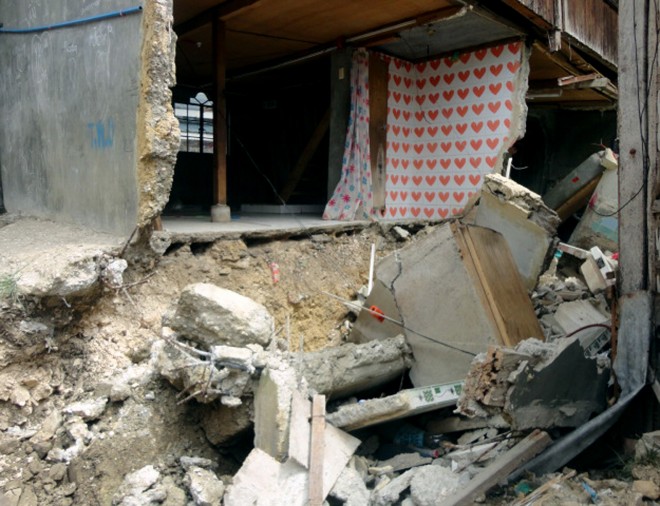
Twenty one apartment units housed in three buildings in a private lot in Barangay (village) Canjulao, Lapu-Lapu City are being considered as condemned after they sustained heavy damage and portions fell into a sinkhole following a 7.2 magnitude earthquake that struck Cebu, Bohol and other parts of Visayas and Mindanao Oct. 15, 2013. CDN PHOTO/NORMAN MENDOZA
MANILA, Philippines – The yellow water from the sinkholes that appeared in quake-hit areas of Cebu and Bohol could be of phosphate, the Department of Environment and Natural Resources said on Thursday.
Liza Manzano, DENR-Mines and Geosciences Bureau, said at a briefing at Camp Aguinaldo Friday that the yellowish water retrieved underground could possibly be phosphatic water.
“It has to be confirmed first. But Bohol is 85 percent limestone and its underground layers have natural deposits of phosphate so the water turns yellow. So probably it’s phosphatic water,” she said.
Because Bohol was mostly made of limestone, it was prone to sinkholes, Manzano said.
According to the US Geological Survey, sinkholes are common where the rock below the land surface is limestone, carbonate rock, salt beds, or rocks that can naturally be dissolved by groundwater circulating through them.
It has no natural external surface drainage–when it rains, all of the water stays inside the sinkhole and typically drains into the subsurface.
Phosphate could cause thickening of bones and teeth to humans if ingested at a certain level. As to the environment, Manzano said this could cause fishkill.
Senior Superintendent Ar’wyn Pagkalinawan cited a report on Thursday by a resident that sinkholes appeared along the coastlines and resulted in fish deaths. The report, however, was being validated, he added.
Manzano said the areas affected by sinkholes include Lapu Lapu in Cebu City; Loon, Calape, Pemandangan and Tubigon in Bohol.
“We already sent teams there conducting posthazard assessment in landslides and sinkholes,” she said.
Additional teams were sent last week to assess the area.
The National Disaster Risk Reduction Management Council also ordered the police to cordon off the areas, particularly those near structures and buildings until the DENR teams are able to assess the area.
Manzano also hoped that it would not rain hard in Bohol as it would be more hazardous.
“Earthquake-induced landslides, rockslides could be converted into debris flow…then it would be rain-induced [landslides],” Manzano said.
RELATED STORIES
Bohol, Cebu residents warned vs giant sinkholes
Bohol quake ‘like 32 Hiroshima bombs’